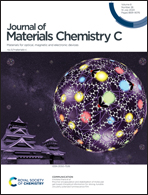Solid-state synthesis of stable and color tunable cesium lead halide perovskite nanocrystals and the mechanism of high-performance photodetection in a monolayer MoS2/CsPbBr3 vertical heterojunction†
Abstract
Herein, we report on a facile room-temperature bulk scale solid-state synthesis of highly luminescent color-tunable CsPbX3 nanocrystals (NCs) with superior optoelectronic performance and exceptional ambient stability. The composition tuned all-inorganic perovskite NCs exhibit high photoluminescence (PL) quantum yield with adjustable emission color in the range 416–691 nm and high color purity (linewidth ∼14 nm). The as-grown NCs are highly stable up to seven months under ambient conditions, and the post-growth annealing results in reduced non-radiative recombination centers and improved PL quantum yield (∼95%) in the perovskite NCs. The low-temperature PL study reveals high exciton binding energy in the NCs, and the highly luminescent perovskite NCs were utilized for the demonstration of color-tunable light-emitting diodes with high luminous efficiency (∼42 lm W−1 for CsPbBr3). We further integrate the CsPbBr3 NCs on direct CVD grown large-area monolayer MoS2 on Si/SiO2 substrates and fabricate a vertical heterojunction photodetector (PD). For the first time, direct CVD grown large area 1L-MoS2 on Si/SiO2 has been utilized here to demonstrate a 1L-MoS2/CsPbBr3 PD of type-II heterojunction with high responsivity (24.3 A W−1 at 405 nm) and extremely fast photo-response with photocurrent growth and decay times of 5.5 μs and 24.0 μs, respectively. The superior performance of the heterojunction PD is attributed to the fast transfer of photogenerated electrons from CsPbBr3 NCs to monolayer MoS2 and n-doping of the MoS2. Our interpretation is fully supported by density functional theory based electronic structure calculations and Kelvin probe force microscopy measurements, which show direct evidence of the charge transfer at the MoS2/CsPbBr3 heterojunction due to a type-II band alignment. Our results pave the way for the large-scale synthesis of highly stable and color-tunable CsPbX3 NCs and their application in bright LEDs and a high-performance photodetector with a fast response.



 Please wait while we load your content...
Please wait while we load your content...